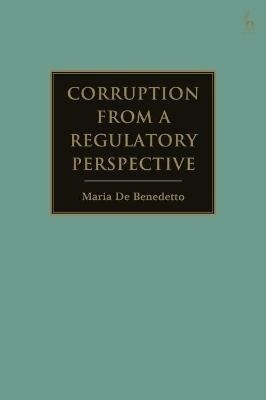
Corruption from a Regulatory Perspective
Hart Publishing (Verlag)
978-1-5099-2921-4 (ISBN)
Maria De Benedetto is Professor of Administrative Law at Roma Tre University, Italy.
1. Rules, Corruption and Controls: Setting the Scene
1.1. Preliminary Remarks
1.2. Rules
1.2.1. Definition
1.2.2. Law is More than Legislation
1.2.3. Does Legislation Threaten the Law?
1.2.4. Regulation and Rules as Key Concepts
1.3. Rules and Behaviour
1.3.1. Decisions about Compliance with Rules as an Individual Problem
1.3.2. Generating Compliance with Rules as an Institutional Problem
1.3.3. Certifying Compliance with Rules as a Company’s Interest (and Cost)
1.4. Functioning of Rules and their Dysfunction
1.4.1. How Rules Work
1.4.2. When Rules Do Not Work
1.4.3. Trust: The Intangible Factor of Rules’ Effectiveness
1.5. Corruption
1.5.1. Definition
1.5.2. A Basic Definition for a Complex Issue: (Simple) Corruption
1.5.3. A Slightly Complex Definition: Corruption as a Regulatory Issue
1.6. Corruption and Conflict of Interest
1.6.1. Corruption as ‘Actuality’, Conflicts of Interest as ‘Possibility’
1.6.2. Criticisms and Paradoxes in Overregulating Conflicts of Interest
1.7. Corruption and Corruptibility
1.7.1. Corruption as ‘Actuality’, Corruptibility as ‘Probability’
1.7.2. Objective Corruption and Corruptibility: Type AP (Administrative Powers) and Type C (Controls)
1.8. Controls
1.8.1. Definition
1.8.2. The Notion of Control from an Anticorruption Perspective
1.8.3. Criticism, Paradoxes and Dilemmas of Controlling
1.9. Controlling Administrative Activities
1.9.1. External Controls
1.9.2. Internal Controls
1.9.3. Criticisms and Paradoxes in Controlling Administrative Activities
1.10. Controlling Private Activities
1.10.1. ‘Desk-Based’ Controls
1.10.2. ‘Field-Based’ Controls
1.10.3. Criticisms and Paradoxes in Controlling Private Activities
2. Anticorruption: Strategies and Risks
2.1. Preventing Corruption: A Contemporary Issue
2.1.1. The Great Temptation: Justifying
2.1.2. The Right Choice: Combating
2.2. Anticorruption between Global Stance and Domestic Strategies
2.2.1. Global Anticorruption Policies
2.2.2. Domestic Administrative Strategies
2.3. Anticorruption: Conventional, Behavioural and Beyond
2.3.1. Conventional Anticorruption
2.3.2. Behavioural Anticorruption
2.3.3. Towards Regulatory Anticorruption
2.4. Risks of Anticorruption
2.4.1. Backfire
2.4.2. Perception vs Reality
2.4.3. Metastatic Bureaucracy
2.4.4. Defensive Administration
2.4.5. Difficulty in Recruitment of Honest and Expert People
2.5. Feasible Objectives of Anticorruption
3. Anticorruption: Rules (Can Good Rules Reduce Opportunities for Corruption?)
3.1. As with Corruption, Anticorruption Starts from Rules
3.1.1. No Rules, No Corruption?
3.1.2. Rules, their Market and their Profit
3.2. Managing Rules, Combating Corruption
3.3. Regulatory Stock
3.3.1. Simplification
3.3.1.1. Simplification and Good Quality Regulation Per Se
3.3.1.2. Simplification and Anticorruption
3.3.2. Advocacy Powers
3.3.2.1. In Competition Law
3.3.2.2. In Anticorruption
3.4. Regulatory Flow
3.4.1. Anticorruption Assessment of Legislation
3.4.1.1. A First Step: Good Quality Regulation Per Se
3.4.1.2. A Second Step: Highly Focused Anticorruption Tools
3.4.2. Tracing Interests
3.4.2.1. Lobbying and Consultation
3.4.2.2. Collecting Interests: The Good and the Bad
3.4.2.3. Regulating Lobbying is not Necessarily the Solution
4. Anticorruption: Controls (Can Controls Help in Reducing Corruption?)
4.1. Controls from a Theoretical Perspective
4.1.1. The Mythology (and Threatening Practice) of Efficient Controls
4.1.2. Controls in Regulatory Theory
4.1.3. Controls and Theory of ‘Policing’
4.1.4. Controlling is Governing, No More and No Less
4.2. Controls from a Practical Perspective: Warnings
4.2.1. Controls have a Hybrid Nature
4.2.2. Controlling Includes Administrative Tolerance
4.2.3. Controls are a Cost
4.2.4. Administrative Capacity of Control is Limited
4.2.5. Planning Controls is not a Simple Task
4.2.6. Sanctions Following Controls Must be Effective in Order to Deter
4.3. Controls from a Practical Perspective: Suggestions
4.3.1. Information
4.3.2. Regulation
4.3.3. Privacy and Data Protection
4.3.4. Planning
4.3.5. Enforcement
4.3.6. Communication
4.3.7. Reform
5. Combating Corruption via Regulation and Controls: Which Formula?
5.1. Corruption (and Anticorruption) from a Regulatory Perspective: A Recap
5.2. Combating Corruption: Why?
5.3. Combating Corruption: How?
5.3.1. Regulatory Anticorruption: From Alternative Theoretical Approaches to an Integrated Strategy
5.3.2. Regulatory Anticorruption Toolkit (Corruptibility Assessment)
5.3.2.1. Incentives or the Genetics of Corruption
5.3.2.2. A Protocol to Identify and Assess Corruptibility
5.3.2.3. Criminal Databases Should Talk Administrative Language
5.3.3. Regulatory Anticorruption in Practice
5.4. Combating Corruption: Who?
5.4.1. Legislators and Regulators
5.4.2. Public Agents and Enforcement Officers (in General)
5.4.3. Anticorruption Bodies (in Particular)
5.5. Trust vs Corruption: Governing the Intangible
| Erscheinungsdatum | 22.10.2021 |
|---|---|
| Verlagsort | Oxford |
| Sprache | englisch |
| Maße | 156 x 234 mm |
| Gewicht | 490 g |
| Themenwelt | Recht / Steuern ► EU / Internationales Recht |
| Recht / Steuern ► Privatrecht / Bürgerliches Recht ► Besonderes Schuldrecht | |
| ISBN-10 | 1-5099-2921-5 / 1509929215 |
| ISBN-13 | 978-1-5099-2921-4 / 9781509929214 |
| Zustand | Neuware |
| Informationen gemäß Produktsicherheitsverordnung (GPSR) | |
| Haben Sie eine Frage zum Produkt? |
aus dem Bereich


